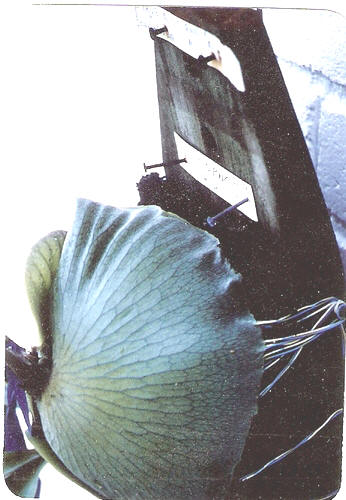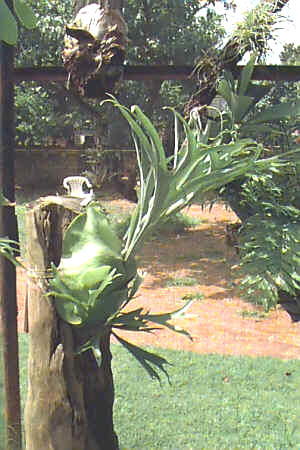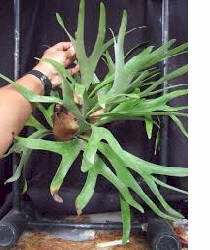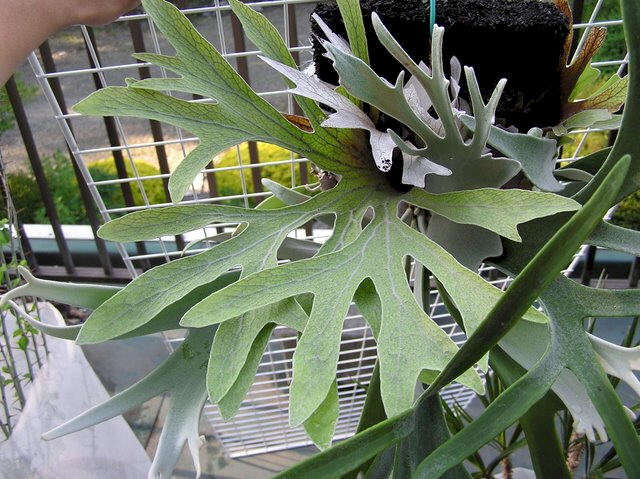|
Platycerium alcicorne
Notice the difference in the shield fronds
between the two
photos. The
one on
the right is from Madagascar, is darker green with many hairs and has a shield frond
similar to the P.
madagascariense with deep ridges and turn nearly black when dead..
|
|
For years the Platycerium alcicorne and Platycerium vassei were thought to be two different species. Wendy Franks in her book Platycerium Fern Facts does not list the P. alcicorne as a unique species, but does list the P. vassei species. Currently most knowledgeable growers believe they are the same plant and today only P. alcicorne is used to classify this platy species. The most common P. alcicorne 'Vassei' found in the USA is the African form pictured top left. It grows in East Africa. The platy with the deep rippled shield frond is from Madagascar and is more difficult to find in collections. Probably because it is more difficult to grow than the African one. The regions in which the African P. alcicorne 'Vassei' grows suggests it is more cold tolerant than most Platycerium. but will not take much frost. Platycerium alcicorne 'Vassei' is a fine choice for an easy Platycerium that can be grown out doors in bright light where frost is extremely rare. To some degree, the P. alcicorne is also similar to the P. ellisii, P. hillii, P. ridleyi, and P. madagascariense in they all grow rounded shield fronds suggesting they are from rain forests with plenty of water and the shield frond protects the rhizome from rotting from excess watering. The Madagascar platys divide into two different forms. One with wide fertile fronds and one with narrow fertile fronds. The form with extremely narrow fertile fronds tend to also have more pronounced veins on their shields. Both the African and the Madagascar plants have similar growing seasons. The shield fronds die in late summer and fall and the plant goes dormant through the winter. Water and fertilized should be minimized during the dormant period. The African form is less tolerant of excess water than the Madagascar form.
For years Roy Vail has suspected the P. alcicorne could be found in
the Seychelles islands, which is in the Indian Ocean, east of
Madagascar and East Africa, but on one of his recent travels (2014),
he concluded there are no Platycerium in the Seychelles. He
found two cultivated in a garden, but one was a P. bifurcatum and the
other a P. hillii, probably imported from Australia. |
 
These photos taken from Roy Vail's web site show the Madagascar P. alcicorne. Also from Madagascar is the P. madagascarinese which has similar deep indentions on the shield frond but they are more like a waffle pattern where these are more like valleys. The P. ridleyi also has a similar shield frond. It is interesting but few photos on Google of the Platycerium alcicorne Madagascar form show these deep valleys Roy reports that the P. alcicorne from Madagascar tends to be darker green with many hairs. Some individuals have fertile fronds that are dark green on the top, and nearly white with hairs on the underside. |
|
There appears to be more differences between the African and
Madagascar platys. The African platy is yellow-green in color,
waxy with nearly no hairs. Their shield fronds turn rich brown
when they die.
The Madagascar plants tend to be dark green, with many hair. Some individuals have fertile fronds that are dark green on top, and nearly white with hairs in the underside. Theri shields become nearly black when dead. And the Madagascar plants develop folds in the upper half of the shields when given enough light.
Roy Vail reports that the Africa plants are somewhat less tolerant of excess water than the Madagascar plants. The Africa plants also pup more freely. Both types are slightly more sensitive to cold than P biforcatum.
This photo on left is from Steve Lucas on Pinterest and does a great job of showing the slender fertile fronds with star like pointed fingers. The shield fronds have turned a rich brown suggesting it is the African form of P. alcicorne. If the shield fronds were black it would probably be from Madagascar. Another clue as to its origins is the color of the shield fronds. They are a little yellowish green and not a dark green as found in Madagascar. A closer observation might reveal they are waxy in appearance with no hair. |
|
[
Plant Glossary ] |




 I
can't find much documentation in this but in photos, the African platy
appears to have long slender fingers on the wide fertile fronds, where
the Madagascar platy has two forms, One with wide fertile fronds and
one form with harrow fertile fronds. This may be a result of the
growing conditions.
I
can't find much documentation in this but in photos, the African platy
appears to have long slender fingers on the wide fertile fronds, where
the Madagascar platy has two forms, One with wide fertile fronds and
one form with harrow fertile fronds. This may be a result of the
growing conditions.